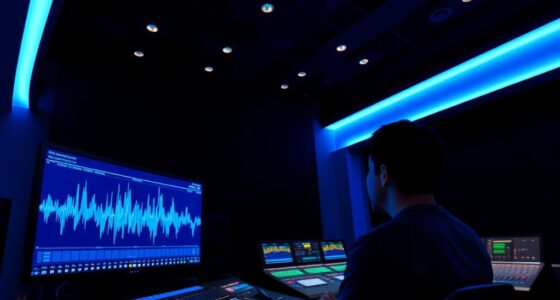As a producer, having high-quality in-ear monitor mixes is crucial for clear, personalized sound on stage. You can adjust your mix easily to focus on desired instruments or vocals, helping you stay engaged and responsive during performances. Proper ergonomics and reliable wireless technology ensure comfort and free movement without signal disruptions. To achieve the best results, optimize your equipment placement and isolate from stage noise. Keep exploring for tips on perfecting your in-ear monitoring setup.
Key Takeaways
- Customize individual monitor mixes for clarity, balance, and comfort to enhance performer focus and overall production quality.
- Utilize wireless in-ear systems to reduce stage clutter, improve mobility, and ensure reliable audio transmission.
- Properly position transmitters and receivers to maintain strong signal quality and minimize technical disruptions.
- Select comfortable, sound-isolating ear tips to improve mix accuracy and performer confidence during long sessions.
- Collaborate with sound engineers to fine-tune mixes, ensuring optimal sound for performers and a polished live performance.

In-ear monitor mixes are essential for performers who want clear, personalized sound on stage. As a producer, understanding how to enhance these mixes can markedly improve your performers’ comfort and performance. One of the key factors to contemplate is stage ergonomics. When performers are comfortable and free from tangled cables or bulky equipment, they can focus entirely on their performance. Proper placement of in-ear monitors, along with thoughtful stage layout, helps minimize stage clutter and allows performers to move naturally without worrying about tripping or pulling their monitors. Good stage ergonomics also means ensuring that wireless technology is seamlessly integrated. Wireless in-ear monitors eliminate the need for cumbersome cables, reducing trip hazards and enabling performers to move more freely across the stage. This freedom not only improves their stage presence but also helps maintain a clean and organized stage environment. As a producer, you should prioritize high-quality wireless systems that deliver reliable, low-latency audio, ensuring performers receive their personalized mixes without delay or interference. This makes a noticeable difference in their confidence and ability to deliver a polished performance. Wireless technology also allows for quick adjustments during the show. If a performer needs more of their vocals or less of the stage ambiance, you can easily tweak their mix remotely, without disrupting the entire stage setup. This flexibility is crucial for maintaining high energy levels and audience engagement. Additionally, think about the placement of wireless transmitters and receivers. Positioning them strategically minimizes signal dropouts and interference, which can be distracting for performers and disruptive to the overall sound quality. As a producer, it’s imperative to communicate with the technical team to ensure these components are ideally configured and maintained throughout the performance. When setting up in-ear monitor systems, you should also pay attention to the comfort of the ear tips. Comfortable, well-fitting ear tips improve sound isolation, preventing bleed from stage noise and ensuring each performer hears their mix accurately. This, combined with wireless technology, creates a more immersive monitoring experience. Moreover, selecting high-quality wireless systems can greatly reduce the risk of technical issues, ensuring a smoother performance. Ultimately, integrating excellent stage ergonomics with reliable wireless systems ensures that performers stay focused on their craft, rather than battling technical issues or discomfort. As a producer, your role is to facilitate an environment where in-ear monitors deliver precise, personalized sound in a manner that supports natural movement and stage presence. Proper planning and implementation of these elements result in a smoother show, happier performers, and a more polished overall production. When you prioritize these details, you’re setting the stage for a seamless, professional performance every time.
Frequently Asked Questions
How Do I Troubleshoot Common In-Ear Monitor Issues?
To troubleshoot common in-ear monitor issues, start by checking for excessive stage noise that could be bleeding into your monitors. Make certain your monitor placement isn’t too close to speakers or stage monitors, which can cause feedback or interference. Verify your connections and settings on your mixer. If you still experience problems, try replacing the in-ear monitors or cables. Adjust the mix to balance sound levels and reduce ambient noise for better clarity.
What Are the Best Practices for Customizing Mixes for Performers?
Creating personalized sound mixes for performers is like tailoring a suit—every detail matters. You should start by asking each artist about their preferences and focus on their stage communication needs. Adjust levels to highlight vocals or instruments, ensuring clarity without overpowering. Regularly check in during rehearsals, making tweaks for comfort and clarity. This proactive approach helps performers stay connected, confident, and engaged throughout the show.
How Does Wireless In-Ear Monitoring Differ From Wired Systems?
Wireless in-ear monitoring offers greater freedom of movement compared to wired systems, but it can introduce wireless latency, which might affect timing. Wired systems tend to be more durable and reliable, minimizing dropouts and interference. You’ll find wireless ideal for dynamic performances needing mobility, while wired options suit stationary setups where durability and consistent sound quality are priorities. Choose based on your performance needs, balancing mobility with stability and durability.
What Safety Precautions Should I Consider With In-Ear Monitors?
To guarantee your safety with in-ear monitors, prioritize volume safety by keeping the volume at a comfortable level to prevent hearing damage. Practice proper cable management to avoid tripping hazards and cable pulls that could cause injury or damage your equipment. Regularly check your monitors for signs of wear, and take breaks to give your ears rest. Staying mindful of these precautions helps protect your hearing and ensures a safe, enjoyable experience.
How Can I Reduce Latency in In-Ear Monitor Systems?
Think of your in-ear monitor system as a race car; to reduce latency, you need a smooth, direct track. Use a wired connection where possible, or choose a low-latency wireless system with robust signals. Make sure your custom fit earbuds create a tight seal to prevent wireless interference, which can cause delays. Regularly update firmware and minimize obstacles around your transmitter to keep your sound racing seamlessly, with minimal lag.
Conclusion
In-ear monitor mixes are essential for producers to stay focused and confident during performances. They allow you to customize your sound, ensuring you hear exactly what you need. Did you know that 85% of live performers say in-ear monitors improve their overall sound quality and comfort? Investing in a good mix can make all the difference, helping you deliver your best work every time. So, prioritize your monitor mix and take your productions to the next level.









